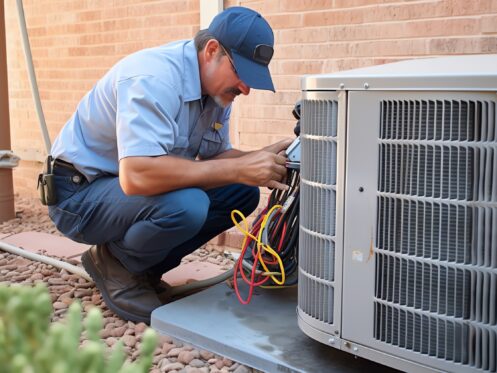Your home’s HVAC system plays a pivotal role in your household’s comfort. It works behind the scenes to keep your house inviting and relaxing, no matter the temperature. However, no matter how important this system is, many homeowners neglect to schedule regular HVAC inspections and spend more money on costly repairs and higher-than-necessary energy costs.
In this guide, you’ll learn more about the benefits of HVAC inspections for long-term efficiency regarding performance, cost savings, and lifespan. You’ll also learn what to expect during an HVAC inspection and how often your system needs a professional inspection.
Enhanced Energy Efficiency
You might find it surprising how much dirt, dust, pollen, pet dander, and other debris can accumulate in your HVAC system. All the filth inside the system causes it to work harder than necessary to maintain desired household temperatures. When your system’s overworked, it consumes more energy and causes utility bills to rise. Routine HVAC inspections by qualified service technicians keep your system clean and reduce energy consumption, ensuring it works at peak efficiency all year.
Fewer Chances of Breakdowns
Have you ever wondered why heating and cooling systems break down at inconvenient times, like when the temperatures are sweltering or bitterly cold? This happens because the system likely has had some mechanical issues for a while, and it can’t handle the extra work it does to keep your home comfortable. Regular HVAC inspections reduce the risk of unexpected breakdowns because minor issues get addressed before they turn into severe mechanical problems.
Increased System Lifespan
Residential HVAC systems aren’t cheap. They’re a substantial investment, and you want your system to last as long as possible. The average HVAC system lasts 15-20 years, but most never make it that long. Many start to show signs of wear and tear around the 10-year mark. Regular inspections can get your system closer to the 15-year mark. During these inspections, technicians check for leaks and mechanical damage that could affect longevity if not repaired promptly.
What to Expect During an HVAC Inspection
A quality HVAC inspection doesn’t cut corners; only a qualified service technician should complete one. Expect our technicians to spend an hour or two inspecting the unit and plan on being available for the inspection. You must stay available to answer questions and approve repair solutions should the technician find a problem.
Here’s what happens during a basic HVAC inspection:
Electrical Checks
The technician performs voltage testing. They also check for failing electrical parts. Technicians must perform electrical checks to ensure any wear and tear hasn’t damaged electrical components, which puts the system at a higher risk of sparking and electrical fires.
Lubrication
HVAC systems have many moving parts. Lubricating mechanical parts like bearings and motors minimize friction and excessive wear and tear.
Condensate Line Inspection
Each time your heating or cooling system runs, it produces humidity. The condensate line removes moisture from the system to prevent buildup. Water can accumulate in the drain pan if the condensate line becomes clogged. Eventually, the water can overflow and damage your attic, ceiling, and portions of the support beams to which the HVAC system is installed.
Airflow Testing
Insufficient airflow causes HVAC systems to become less efficient, ultimately causing poor performance and high energy costs. Problems that lead to airflow issues include leaky ductwork, failing dampers, dirty air filters, and improper fan speed. During an HVAC inspection, technicians check those components and identify and repair any damage to improve airflow. Our technicians might advise you to schedule ductwork cleaning if we notice debris and piles of dust accumulating.
Check Refrigerant Pressure
HVAC technicians check the refrigerant’s condensing pressure when the refrigerant changes from gas to liquid. As the refrigerant moves through the condenser, heat is released. This process drops the temperature and results in condensation. The technician uses a pressure gauge to check for the appropriate refrigerant pressure. Our technicians check for condenser coil and fan damage if the pressure is too high. They also check for refrigerant leaks, another problem that causes too-high pressure.
Check and Clean the Blower Motor
The HVAC system’s blower motor controls airflow. It turns on the fan in your heating and cooling system. Routine blower motor cleaning extends the system’s life and reduces mechanical problems caused by wear and tear.
A professional HVAC inspection consists of multiple checks. A thorough multi-point inspection is the surest way to ensure long-term efficiency and keep all manufacturer warranties intact. When you spend several thousand dollars on a new HVAC system, you want it to last as long as possible and know your warranty protection will cover you if problems pop up. Most warranties require maintenance records if you make a claim.
How Often Should You Get an HVAC Inspection?
Regular HVAC inspections reduce emergency service calls and improve the unit’s energy efficiency. The best time to schedule an HVAC inspection is in the fall and the spring. This inspection schedule gives you peace of mind that your system will work when needed. You don’t have to worry about calling for heating or cooling repairs when temperatures have reached their highs and lows, and everyone is trying to get service.
What to Do in Between Inspections for Long-Term Efficiency
Between inspections, it is important to do a little work to maintain the system. Make sure to change the filter every 30 days to ensure sufficient airflow if you own pets or smoke and 60 days if you don’t own pets or smoke. During the summer, hose off the air conditioner’s outside unit to remove debris, such as sticks, leaves, and grass clippings. Also, if you notice the heating or cooling system isn’t running well or using more energy than usual, schedule a diagnostic service call with one of our qualified service technicians.
Reliable HVAC Inspections
Blue Best Plumbing, Heating, Air, & Generators is a woman-owned, BBB-accredited, full-service HVAC and plumbing company in Bountiful, UT, and surrounding communities. We offer full HVAC and plumbing services. Some of the benefits of our HVAC maintenance plan include:
- Discounts on repairs and installations
- Extended labor warranties
- No after-hour service charges
- Priority service
Maintenance keeps your HVAC system running better for longer and can earn you significant savings on heating and cooling bills. It also prevents many problems that can shorten the system’s lifespan. At Blue Best Plumbing, Heating, Air, & Generators, we take pride in our heating, cooling, and plumbing services. For over 20 years, we’ve made it our goal to provide our customers with outstanding customer service and exceptional repair and replacement services. We’re a Lennox Premier Dealer, but we also install other makes and models. Finding you the perfect system for your home and helping you keep it maintained is what we do best. We also offer financing on approved credit to make it easier to heat and cool your home for less out-of-pocket costs. Helping you achieve maximum home comfort is what we do best!
Contact us at Blue Best Plumbing, Heating, Air, & Generators today if you have been slacking on HVAC maintenance at your Bountiful home.








